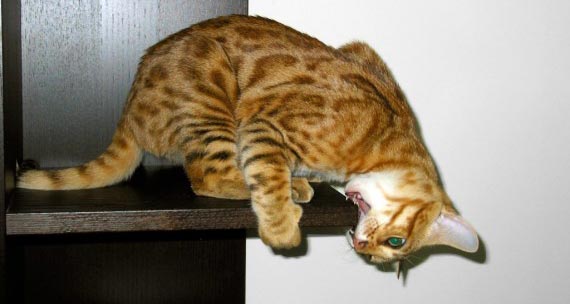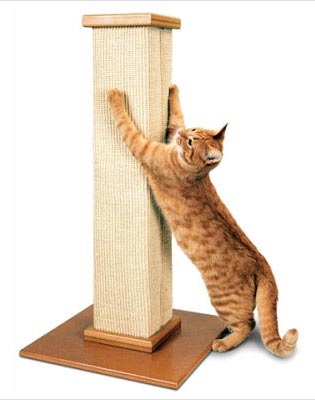[dropcap]I[/dropcap]s your kitty turning into a little monster? Bengal cat behavior problems can be quite irritating and are probably the most common reason some of them lose their homes.
But the first step to correcting them is to actually try understanding your furry friend and the cause of these issues: they can be due to behavioral or medical causes.
Bengals are extremely intelligent and will find ways to communicate their wishes to you. Bengal cat behavior problems can sometimes be the result of this form of communication.
Therefore it is very important to try to understand what kitty is trying to tell you and then address the issue rather than punishing him. Bengals are not malicious, or deliberately destructive.
Dealing With Bengal Cat Behavior Issues
You must never ever hit your cat! It is completely ineffective since they do not understand physical punishment. Rather, they will see this as an aggressive action and you will destroy the trust and security required for a good relationship. Your cat will remember such an attack and may hold a serious grudge.
Instead, learn why your cat does certain things and then work with your cat to correct any problems. Clapping loudly or raising your voice with assertion when they may “get out of hand” are effective tools. Here are some common Bengal cat behavior problems and ways to address them.

Scratching Carpet or Furniture
First of all, it is important to understand that scratching is natural for cats and they do it for a variety of reasons. Cat’s paws have scent glands and scratching is one of the methods they use to mark their territory. It also provides a much needed means for stretching and works the muscles of the cat’s front quarters.
Also cats scratch to shed the outer layer of their claws. Finally, cats scratch because it feels good. Just think how much better you feel after a good stretch first thing in the morning.
You will never be able to make your cat stop scratching, but you can re-direct his scratching to acceptable surfaces. Here is where the need for an appropriate scratching post comes in.
Cats like rough surfaces and prefer to scratch vertically. Sisal rope scratching posts are ideal for this purpose. They love the smell and texture of the natural fiber and it is tough enough to stand up to repeated use.
The key to getting kitty to use a scratching post is its location. Cats always like to have a good stretch and scratch upon waking from a nap.
So, keep a scratching post in areas where your cat likes to sleep. We have at least one sisal post in all the main living areas as well as in the bedroom. If your cat has been scratching carpet or furniture, place a sisal scratching post as close as possible to this spot.
 If your cat starts to scratch the sofa or carpet, say “no” firmly and place him at the scratching posts or cat tree. Praise him when he uses the post.
If your cat starts to scratch the sofa or carpet, say “no” firmly and place him at the scratching posts or cat tree. Praise him when he uses the post.
You may need to rub a bit of catnip in the scratching post to get his attention. Make sure that the post is tall enough for an adult cat to be able to reach up and have a good stretch.
It must be sturdy and not tip over as this will discourage your cat from using it. Most cats are drawn to the sisal naturally and prefer it over carpet or other surfaces. I highly recommend the “Ultimate Scratching Post“. It’s a durable post made with fibrous, durable sisal and it measures 32 inches high to allow your Bengal to stretch vertically.
Cat trees with sisal posts are a cats dream come true. Also, try cleaning the area that you don’t want him to scratch to remove his scent. You may have to temporarily cover the area with foil, shelf paper, or special paper (available in pet supply stores) to discourage him from using this area.
Jumping on Counters and Tables
Bengal cats love food and they know that wonderful food smells come from counters and tables. The moment your back is turned, your Bengal will try to jump up and taste what’s cooking.
Not only is having a Bengal on the counter while you are cooking unsanitary, it could also be dangerous. Many cats have been burned by a hot stove or hot steam and been cut by sharp knives.
There are several different ways of letting kitty know that this area (or some other area you choose) is off limits. Give him a firm “no” in his face to let him know this is unacceptable behavior.
Having a water bottle handy and giving your Bengal a spraying is not recommended and not really effective. A better method is orange peel. Most cats hate the smell of citrus and I usually eat an orange a day. So I put the fresh orange peels everywhere I don’t want my Bengal to go.
Or you could take pieces of masking tape and fold them in loops with the sticky side out. Place these on the counter where kitty is most likely to jump. Cats hate it when their feet come in contact with the sticky tape.
It may take some time, but eventually your Bengal will learn that certain areas bring unpleasant consequences and will avoid them. Each Bengal is unique and will respond differently to these methods. For example, each cat must be dealt with individually to see what works.
It also helps to feed your Bengal cat just before you begin preparing or serving food so that they will be less interested in yours.
Litter Box Problems
Bengal kittens are trained to use the litter box before you even bring them home. However, if you decide to use a different litter than what they are used to, you may have to re-introduce your new kitten to the new litter in this way: I recommend “Swheat Scoop“, as it is natural, flushable and the cats love it!
If you use another litter, introduce it slowly by putting his old litter on the top of the tray and your new litter on the bottom. It can take from a few days to a couple of weeks of gradually adding more and more of your litter to the old one before you are successful in switching over to 100% “your” litter.
One thing I have learned about cats over the years, is that if they are upset about something they will let you know by scratching, peeing or pooping somewhere they shouldn’t to get your attention. They do not do this out of maliciousness or revenge but rather it is a form of communication. Try to understand what they are telling you and then deal with that issue.
If your cat should eliminate somewhere other than the litter box, he or she is trying to tell you something. It could be a medical problem. A urinalysis may be necessary.
However, suddenly switching foods can cause diarrhea which can also result in “accidents”. Always mix the new food with the old, gradually increasing the ratio of the new food, over a week or two, to allow the cats digestive system to adjust.
So, when there is a problem, ask yourself: “What has changed recently?”.
Cats also react to stress and change in the family such as moving to a new home. Sometimes with new kittens, the problem is the location of the litter box. Young kittens need to have the litter box nearby until they get their bearings.
Don’t expect them to find a litter box tucked away under your basement steps. Chances are, they were used to having a litter box in the room with them before coming to your home. Keep an eye on him if he looks like he is searching for something and meowing, it is probably his litter box he is seeking out.
Start by having the litter box nearby and then move it to a preferred location once your kitten knows it’s way around your home. If you have a large house with many levels, have one on every level.
A good rule of thumb is this… a litter box for every cat and then one more! Also, start out with an uncovered litter box, then add the lid later on. “Listen” to your cat and negotiate a compromise that is acceptable to both of you.
Remember, your Bengal is extremely intelligent and cannot be forced to do anything it doesn’t want to do. On the other hand, with proper training their thinking can be re-directed and Bengal cat behavior problems can be solved with patience and understanding.
Distraction works wonders and if a kitten or cat is doing something you do not want, give them something better to do or play with.
[products limit=”3″ columns=”3″ orderby=”id” order=”DESC” visibility=”visible”]




